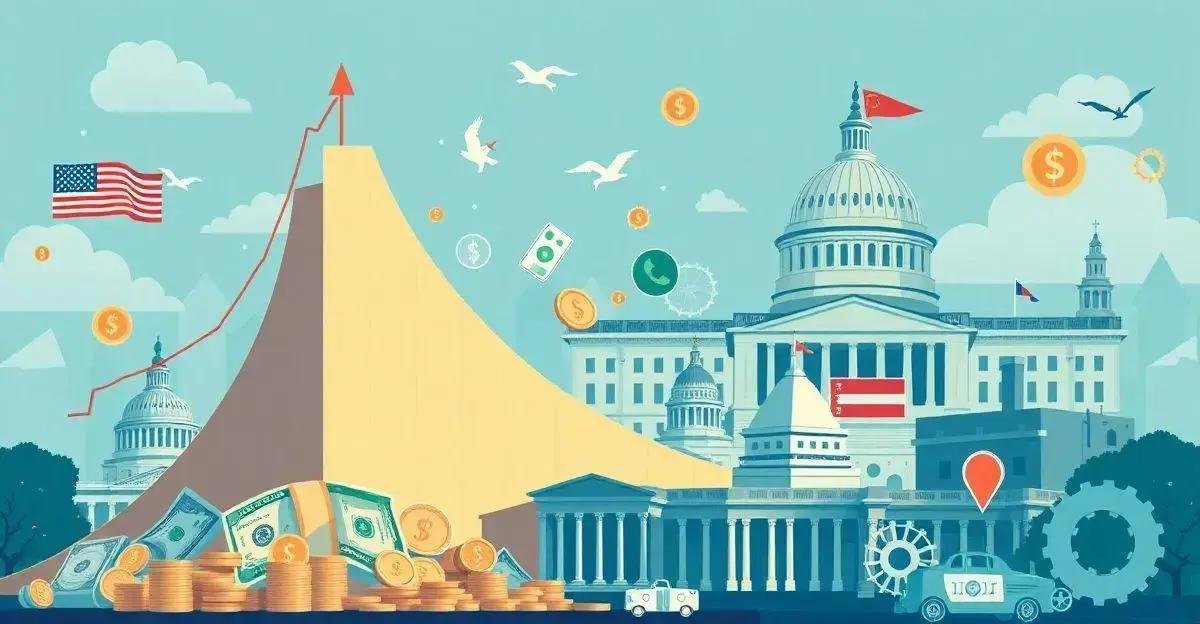Public debt, often shrouded in mystery, plays a significant role in the global economy.
As governments borrow money to finance their activities, the accumulation of public debt can have far-reaching consequences on economic growth and stability.
In this article, we’ll delve into the world of public debt, exploring its definition, types, and impact on the economy.
Veja também: How to Start Dropshipping with US Suppliers
By understanding the intricacies of public debt, we can better navigate the complexities of economic policy-making and make informed decisions for a more sustainable future.
Public Debt: Definition and Types
Public debt, also known as government debt, refers to the amount of money borrowed by a government to finance its activities.
There are two main types of public debt: internal debt, owed to domestic creditors, and external debt, owed to foreign creditors.
Government bonds are a common way for governments to raise funds for public debt. These bonds are essentially IOUs that promise to pay the lender a fixed rate of interest and return the principal amount at maturity.
Other types of public debt include loans from international organizations, such as the International Monetary Fund (IMF), and debt owed to private creditors.
Understanding the different types and forms of public debt is crucial for investors, policymakers, and anyone interested in the global economy.
The Impact of Public Debt on Economic Growth

Public debt can have both positive and negative effects on economic growth. On the one hand, public debt can stimulate economic growth by allowing governments to invest in infrastructure, education, and healthcare, which can increase aggregate demand and boost economic activity.
On the other hand, high levels of public debt can lead to higher interest rates, reduced government spending, and increased taxes, which can slow down economic growth and even lead to recession.
Studies have shown that a moderate level of public debt can have a positive impact on economic growth, while excessive debt can lead to negative consequences. Therefore, it is essential for policymakers to strike a balance between fiscal responsibility and economic stimulus.
Additionally, the impact of public debt on economic growth can vary depending on the country’s specific economic conditions, institutional framework, and policy responses.
Managing Public Debt: Strategies and Solutions
Managing public debt requires a combination of strategic decisions and effective solutions. One key strategy is to adopt a sustainable fiscal framework, which involves setting realistic budget targets and ensuring that government spending is aligned with economic priorities.
Fiscal discipline is essential for reducing public debt and preventing debt crises. Another strategy is to diversify the government’s revenue streams, such as by increasing taxation or exploring alternative sources of funding, such as public-private partnerships.
Additionally, governments can implement debt management strategies, such as debt restructuring or debt relief programs, to address debt sustainability concerns. Furthermore, adopting a long-term perspective and considering the impact of public debt on future generations can help policymakers make informed decisions about debt management.
Conclusion: The Future of Public Debt and Economic Stability

In conclusion, public debt is a complex and multifaceted issue that requires a comprehensive approach to manage effectively.
By understanding the definition and types of public debt, its impact on economic growth, and the strategies and solutions for managing it, policymakers and investors can make informed decisions about debt management.
The future of public debt and economic stability depends on striking a balance between fiscal responsibility and economic stimulus, and adopting sustainable fiscal frameworks and debt management strategies.
As the global economy continues to evolve, it is essential to monitor and adapt to changing circumstances, ensuring that public debt is managed in a way that supports economic growth and stability for generations to come.
Frequently Asked Questions about Public Debt
What is public debt, and how does it affect the economy?
Public debt, also known as government debt, refers to the amount of money borrowed by a government to finance its activities. It can have both positive and negative effects on the economy, depending on the level of debt and how it is managed.
How does public debt impact economic growth?
Public debt can stimulate economic growth by allowing governments to invest in infrastructure, education, and healthcare, but high levels of debt can lead to higher interest rates, reduced government spending, and increased taxes, which can slow down economic growth.
What are some strategies for managing public debt?
Strategies for managing public debt include adopting a sustainable fiscal framework, diversifying revenue streams, debt management strategies such as debt restructuring or debt relief programs, and adopting a long-term perspective.
What is the future of public debt and economic stability?
The future of public debt and economic stability depends on striking a balance between fiscal responsibility and economic stimulus, adopting sustainable fiscal frameworks and debt management strategies, and monitoring and adapting to changing circumstances.
How can small businesses benefit from public debt management?
Small businesses can benefit from public debt management by understanding the impact of public debt on the economy, advocating for policies that support small businesses, and developing strategies to manage debt and stimulate economic growth.
What are some common misconceptions about public debt?
Some common misconceptions about public debt include believing that public debt is always bad for the economy, thinking that high levels of debt are the only way to stimulate economic growth, and assuming that public debt only affects developed countries.




